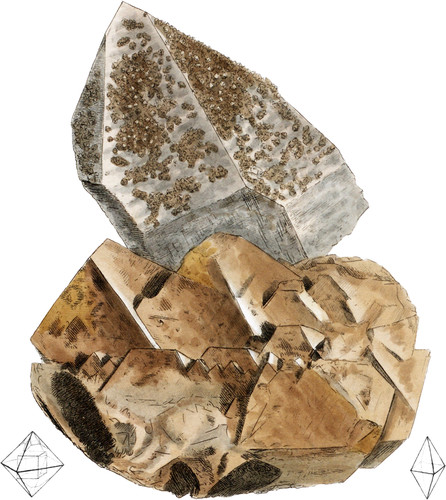 Enlarge
Enlarge
Exotic Mineralogy
Scheelate of Lime
- Syn.
- Wolfram de couleur blanche. Romé D’Lisle iii. 264.
- Tungsten. Kirwan ii. 314.
- Scheelin calcaire. Haüy Traité iv. 320. Tabl. 118. Bournon Catal. 438.
- Schwerstein. Werner.
- Tungstate of Lime. Thoms. Syst. Chem. ed. 3. iv. 543.
Tungstate of Lame is one of those minerals that had long been known before its real nature was understood: thus it bad passed for a white ore of Tin, an ore of Iron, &c. when Scheele discovered the new metal it contains in the state of oxide combined with Lime. Its weight and its frequently accompanying Tin ores led to its being confounded with them, but its softness and inferior lustre readily distinguishes it.
It seldom occurs massive, although it is sometimes found in large masses of more or less perfect crystals, but is generally dispersed in small crystals, which are often collected in globose groups, upon the surface of Quartz crystals or Mica in large hexahedral plates: sometimes it is dispersed through masses composed of Tin, Quartz, Chlorite, &c. the form of the crystals is most commonly that of an octohedron, approaching nearly to a regular one, its angles being 107°26′ and 113°36′; but the primitive is according to Bournon and Haüy, an acute octahedron, of which the angle of incidence of one pyramid on the other is 130°20′; laminæ are easily discernable parallel to both the octohedrons, but those parallel to the latter are the most brilliant, and are therefore adopted for indications of the primitive, the others may arise from concentric coats upon small crystals. Haüy formerly described the fractures, leading to the primitive, as parallel to the faces of a cube, with which, at first sight they appear to coincide, when they are not very regular, and only some of them are visible.
The specimen copied in the lower figure, is preserved in the British Museum, it is from Schöenfeld, in Bohemia; the other figure exhibits the more common appearance in small oetohedrons upon quartz. The outlines shew on one hand the primitive, and on the other the secondary octohedron, with small remains of the primitive upon its edges, and a modification between them. The cube within shews the direction of the fracture formerly attributed to it by Haüy.
Scheelate of Lime was found by Klaproth to contain,
| From Schlakenwald. | From Cornwall. | |
|---|---|---|
| Acid of Scheelium | 77.75 | 75.25 |
| Lime | 17.60 | 18.70 |
| Silex | 3.00 | 1.56 |
| Oxyde of Iron | 1.25 | |
| Oxyde of Manganese | 0.75 | |
| 98.35 | 97.71 |
I have never met with any specimen from Cornwall, nor am I aware that there exists one in any English cabinet, or I should have been anxious to have exhibited it in my British Mineralogy before it was concluded.

